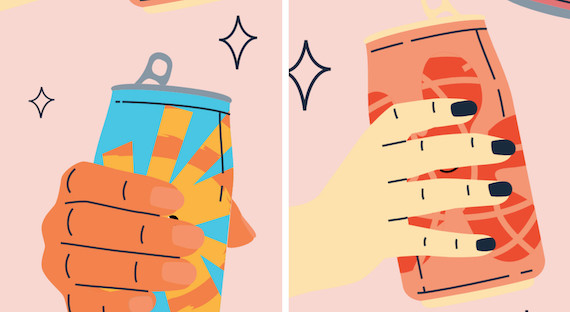The concept feels like a modern one, a convenience welcomed in the era of hard seltzers and RTDs, but the format has history. Wineries in the US began attempting to can wine in 1936, just a year a¢er beer had been successfully canned. The practice wouldn’t be nearly as successful – unstable liquid, low-quality and diseased wine – and primitive canning techniques meant that canned wine would quickly spoil and attempts to package it in aluminium were mostly shelved.
By the 1970s, a lot of these issues had been ironed out and one company that knows a thing or two about canned drinks, Coca-Cola, saw potential. In 1977, it bought New York’s Taylor Wine Company, then the sixth most popular domestic wine producer in the US, with sights set on the in-flight channel.
Coca-Cola claimed that its singleserve canned Burgundy, Chablis and rosé would save airlines space, weight, and ultimately fuel, but passengers weren’t keen, the wines didn’t take o, and Coca-Cola sold the brand to Seagram’s for $200 million in 1983.
It wasn’t until 2004, and the release of Niebaum-Coppola’s Sofia Mini Blanc de Blancs, that canned wine went mainstream in the US. The celebrity association, bold pink can and attached straw nailed the unpretentious, unapologetic, and perhaps unsophisticated identity that stuck with the format.
Globally, the category is now more popular than ever. In the States, it is worth more than $86 million (Nielsen) and Australia has proven to be a hotbed of premium canned wine brands.
“Canned wine in the UK has been in steady triple-digit growth now for two or three years and is worth over £10 million,” says Marc Laventure, cofounder of Canvino, a brand producing canned single-estate wine from Lombardy.
It’s a category in the ascension, a beneficiary of the rise of convenience and consumer demand for singleserve, on-the-go quality.
“We are seeing increasing usage data, especially in the US, where canned wine awareness levels are now at 38% of regular wine drinkers, up from 23% in 2017,” says Richard Halstead, chief operating officer for insights and custom analytics at Wine Intelligence. “Our data is showing the main driver is convenience, and occasions are outdoor drinking and attending events.”
Familiarity and the burgeoning offer may be driving the growth, but for premium retailers, an evolution in the format’s higher-end offering has made canned wine viable.
“The quality of wine placed in alternative formats to bottles has improved massively in the last few years,” says Waitrose buyer Marien Rodriguez. “Canned wine is a growing category and the drivers for this growth are high-quality, attractive designs and the convenience and sustainability of this format. Customers are excited about the advantages of this format and sales can confirm this with all styles reporting growth year to date.”




